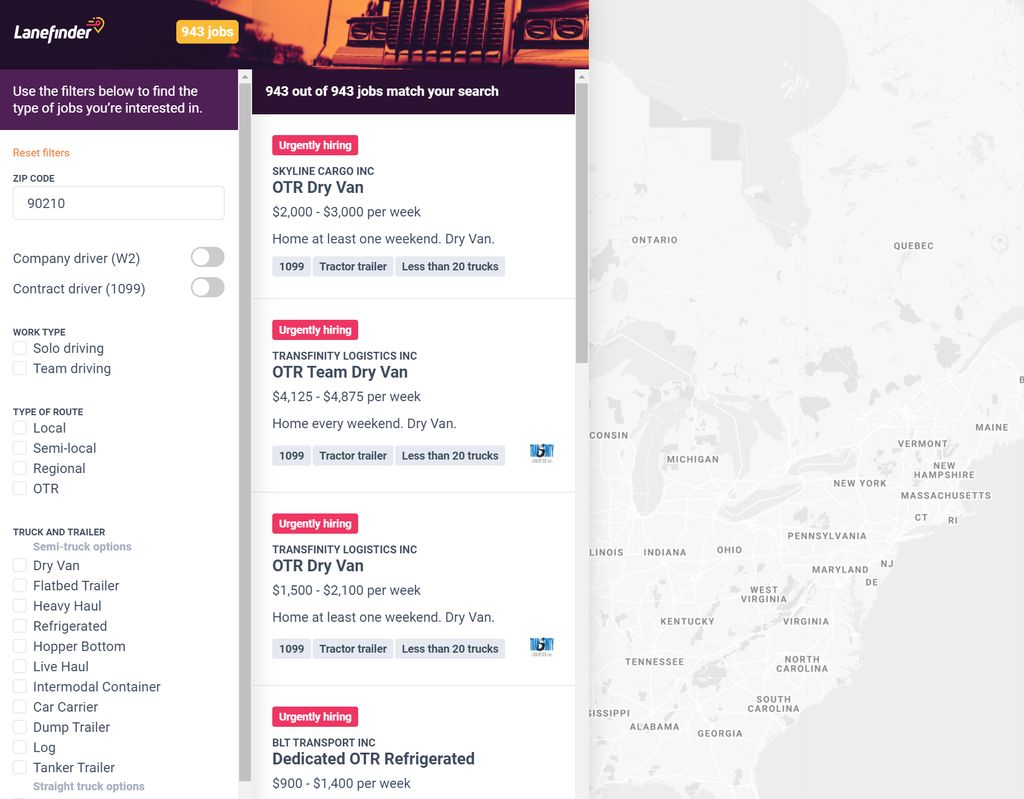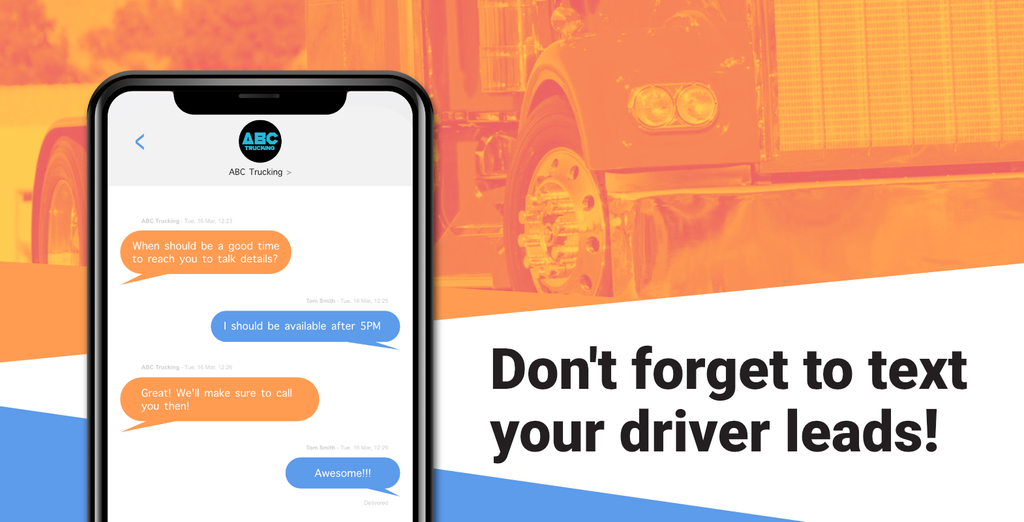Truck driver recruiters are 90% more likely to hire a driver if they contact them within 5 minutes of receiving an application.
That sounds crazy, right? But it’s actually a little known insider fact. One that we’ve been able to observe first hand with the companies we’ve worked with.
According to industry veteran and YouCruit’s Director of Business Development, Jeff Martin:
”Your speed to contact (...) an applicant greatly increases or reduces your chances of hiring that driver. Remember, you're not the only one courting this driver. Even if you were first to contact, you have to maintain that contact speed throughout the communication cycle."
He also adds:
"You can easily lose your advantage for being super fast on your initial contact if you aren't equally fast on the proceeding communications."
The take-away: Simply reaching for that phone as soon as you get an application isn't enough. You need to be on it through every step of the communication process!
Here are the 3 things you should remember when contacting a driver lead:
-
Your goal is to beat the other recruiters - It's always safe to assume that you are not the only company the driver has applied to. Each moment you're not closing the driver, the more likely other companies are to steal the driver from you.
-
Take the time to communicate personally - Automated messaging does not count as contact. The only way to establish a solid rapport and create a lasting impression with the driver is to contact them personally. Choose to call the driver, text them, or email them instead. Automated messages do not tell a driver that you truly care.
-
Every driver lead is a bomb about to go off - Each driver lead you receive is a bomb with a lit fuse. It's only a matter of time before the fuse burns and your lead evaporates. You have a short window of time to neutralize it, otherwise... BOOM! And your shot at the hire is gone.
See it as making a sale. When you’re on the phone with a qualified driver, you should make it your mission to close them as soon as possible. If they’re eager, start making a plan to get them on a flight, bus, or train to your next scheduled orientation right away.
Time is money

Truck drivers value their time. That's why they're picky about who they work for and what kind of job they're willing to do. Each minute a driver spends on your recruitment process is a minute they could spend earning... you get the picture.
Tim Crawford, the current President at Tenstreet, has, on many occasions, stressed the importance of companies optimizing their 'time to hire'. In a Tenstreet blog about essential recruiting metrics, he states:
"One of the unfortunate results of the driver shortage is that qualified drivers are never on the job market for long. A driver is likely to quickly receive a job offer at another carrier, and isn’t going to wait around for a job offer from your company.
He continues,
That is why it’s crucial to make sure that candidates are being assessed and moved through your recruitment process as quickly as possible." (...) It’s important to measure both the elapsed time from first contact to offer, but also the elapsed time for intermediate steps as well."
A driver's time is valuable whether they get paid by the mile, by the load, or by the hour. They will not appreciate having their time wasted, and the more you drag on the hiring process, the less likely you are to hire them. That is why it's so important to keep up your speed and efficiency through every step of the hiring process.
By communicating with the driver efficiently you demonstrate that you:
- Respect their time.
- Have a clear and professional recruitment process.
- Are there to continue communicating with the driver even after they are hired.
Hiring a driver quickly signals that they will have similar experiences during their lifecycle with your company, particularly with dispatch communications. Making a good impression at this stage can even help improve your driver retention.
Your process matters
If you are to have a shot at being a killer driver recruiter, your entire hiring process needs to be speedy. Your first and second call with the driver will not be enough to keep them sticking around through an otherwise lengthy and clunky recruitment process.
Ask yourself, are all of your recruitment processes as efficient as they can be?
- Pre-vetting - How quickly can you identify drivers that fit and disregard those that don't?
- Application - Is your application process clunky, time consuming, and inefficient? An inefficient application process will cost you many, many potential hires.
- Running reports - Do you have a smooth and digitized way to obtain reports & releases?
- Making an offer - How quickly can you get the driver on the line and close the deal?
- Onboarding - How long does it take you to arrange orientation & introductory training?
Save the above points as a checklist and ask if you've nailed each point on that list. Odds are you haven't, but that's okay. Many companies find it exceedingly difficult to stay on top of things without the right tools and technologies. And in an industry that's notorious for lagging behind technologically (cough, fax machines), it's no surprise that many carriers can feel overwhelemed.
Technology has upped the tempo of how all business is done. The world's heartbeat surges with electric energy — and it's no longer a beat you can drum to by doing things the way they did in the 70s.

I've spoken to carriers that still send their application forms to drivers by mail. That's cute, but come on...
Yes, not every carrier has the resources to afford the technology that would enable them to hire more efficiently.
However, we're determined to change that. Currently, we're hard at work on making YouCruit the platform to help small and mid sized trucking businesses the same tools and technological power as the largest carriers in the industry.
Driver recruiting software should be more than a tool to help source or manage candidates. It can improve every step of your hiring process and allow you to be more confident in growing and expanding your company. We think that giving the vast majoritiy of carriers in the US access to previously prohibitive tech is the way forward.
How to optimize your process
Now that you know how important speed is to your hiring process, you're probably eager to get implementing. But before you go and start making life-changing improvements to your business, we want to leave you with some helpful tips.
Tip One: Streamline and digitize your application process.
This is the big enchilada right here. First, you need to make sure your antiquated hiring process is not shooting you in the foot. To avoid that, you're going to need good tech. Good trucking industry specific recruitment software improves each and every step of your recruitment process, and it's an absolute must have before you proceed with anything else. If the software doesn't make it easier for you to pre-vet, get applications, run reports, and reach out to drivers, do not settle. Pick a solution that streamlines every step of your application process and you'll be way ahead of where you currently are (not to mention, far ahead of your competitors).
The bottom line: Trucking specific recruitment technology is an absolute must if you are to improve your time to hire.
Tip Two: Utilize text messaging as much as possible during the hiring process.

Good recruiting tech makes it easier to message all of your driver applicants seamlessly.
Often, the drivers you reach out to will be on the road. A typical recruiter will try calling them once or twice, then resort to sending emails. The problem with emails is that a driver will typically check them once or twice a day, if at all.
The bottom line: Text messaging helps the driver keep your company top of mind and gives them an opportunity to respond when they have as little as two minutes of downtime.
Tip Three: Automate as much of your report running as possible.
How do you obtain driver reports and releases? What does that process look like and how long does it take? Unless you're employing automated solutions, it's likely that your process is currently not fast enough. With digital release forms (as part of your digitized application process), you can make it easy and fast for drivers to sign and confirm their releases in a matter of seconds.
The bottom line: Digitized reports and releases make it easier and faster to confirm a driver's identity and filter out third party applications with photo identification.
Tip Four: Train your recruiters to catch 'knock-out' drivers.
You want your recruiters to have their eye on the ball. If you're a company owner, you likely know exactly the type of driver you want on your team. Make sure your recruiters are on the same page as you. By training them to look out for particular signs and signals, you can hone in on killer candidates and focus as much of your attention on them.
The bottom line: If you're going for speed and efficiency, make sure you don't exhaust yourself chasing the wrong drivers.
Conclusion
Your time to hire is just one of many key metrics you should keep in mind when recruiting. And even though it's one piece of the puzzle, it's a damn imporant one. As it stands, a company that is conscious about their recruitment process is a company that's steps ahead of the majority of the industry. That's a big pay off for just a bit of extra thought and effort.
Besides, organizing and understanding your recruitment will help you address deep seated issues that may be holding your company back from serious growth. By setting speed, communication, and structure as your top priorities, you'll identify the weak spots in your current workflow. Maybe you'll realize that you need more recruiters, better training materials, or simply better access to concrete data. Either way, it'll open your eyes to bigger and better opportunities.
There's certainly much more to say on the topic of speed and communication in recruiting, and we plan to continue this conversation in the future. But for now, this should serve as a good kick off point to get you thinking about recruitment speed in your organization.
If you have any specific questions or would like to have a conversation with us, shoot an email to sales@youcruit.com any time.